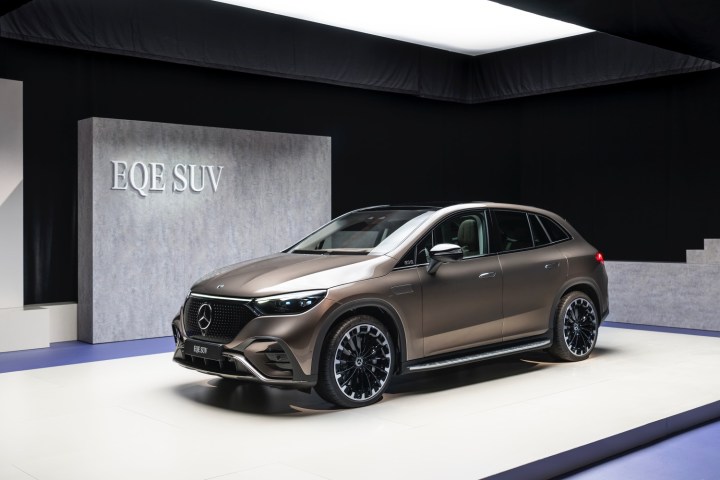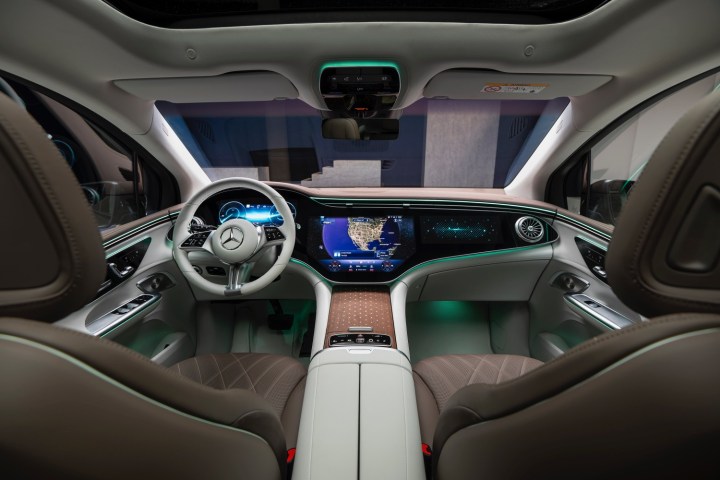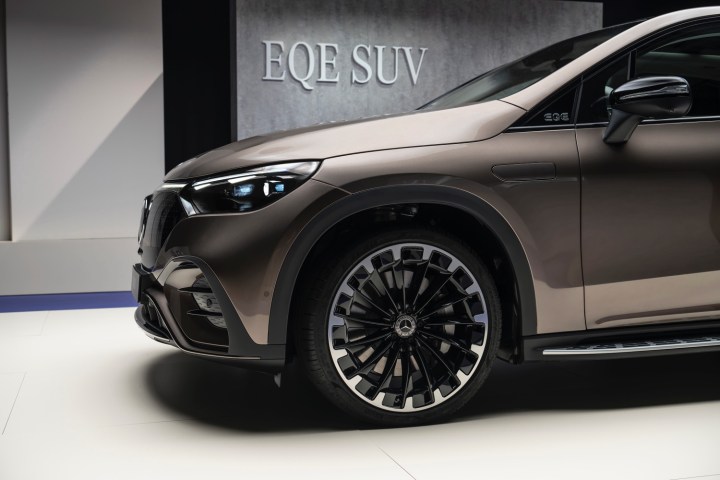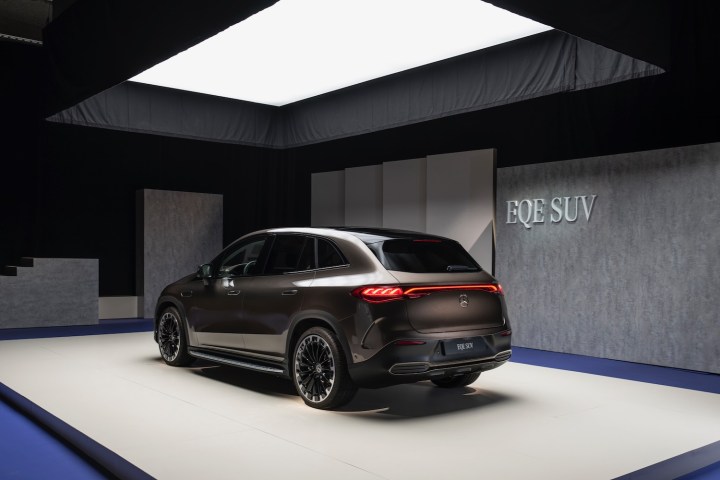As Mercedes-Benz has steadily expanded its EQ range of electric cars, the lineup has become a bit like the late stages of a Tetris game. It’s mostly complete, but with a few gaps still left. And the 2023 Mercedes-Benz EQE SUV is the piece that perfectly fits one of them.
Mercedes recently launched two other electric SUVs at opposite ends of the price spectrum. The EQS SUV is positioned as the lineup’s flagship, while the EQB is the entry-level model. The EQE SUV slots between those two in size and, presumably, price. The latter hasn’t been confirmed yet, and likely won’t be until the EQE SUV’s planned March 2023 on-sale date.
Design
As the name says, the EQE SUV is a utility-vehicle version of the EQE sedan, which will likely beat it to showrooms by a few months. Mercedes did the same thing with the EQS, which is available in both SUV and sedan body styles.
With its tall, upright profile, the EQE SUV definitely looks like a proper SUV compared to the low-slung EQE sedan. Park it next to an EQS SUV, though, and you’ll have to get out a measuring tape to spot the differences.
The EQE SUV is 0.6 inch narrower and 1.2 inches lower than the EQS SUV, but the most significant difference is in length. The EQE SUV is 10.3 inches shorter than the EQS SUV, with a 2.1-inch shorter wheelbase. And while the EQS SUV has three-row seating, the EQE SUV has two rows. Based on our experience with the EQS SUV’s third row, that’s not a big loss.
The interior design theme carries over from other Mercedes EQ models, with an expansive sloping dashboard designed to accommodate many screens, and multicolor ambient lighting that should look pretty dramatic at night. However, leatherette upholstery is standard, rather than real leather, which Mercedes is now spinning as a vegan option.
Tech
The standard infotainment system includes a 12.8-inch portrait-oriented touchscreen and 12.3-inch digital instrument cluster with wireless Apple CarPlay and Android Auto. As with the EQE sedan, expect Mercedes’ Hyperscreen display, which adds a front-passenger touchscreen for a total of 56 inches of screen space, to be available as well.
Other notable standard tech features include a fingerprint sensor to activate individual driver profiles and a Burmester 3D surround sound system with Dolby Atmos. A head-up display and the augmented reality navigation system previously seen on other Mercedes models are optional.
The EQE SUV also gets the expected array of driver aids, including standard automatic emergency braking, blind spot monitoring, and lane keep assist. An optional Driver Assistance Package adds features like Distronic adaptive cruise control, Active Steering Assist automated lane centering, and vehicle-to-vehicle (V2V) communication, which allows the car to send and receive warning messages about road hazards.
Specifications
The EQE SUV launches in single-motor rear-wheel drive EQE 350+ and dual-motor all-wheel drive EQE 350 4Matic and EQE 500 4Matic guises. The 350+ has 288 horsepower and 417 pound-feet of torque, while the 350 4Matic raises torque output to 564 lb.-ft. The EQE 500 4Matic has 536 hp and 633 lb.-ft. of torque.
Mercedes quotes zero to 60 mph times of 6.3 seconds for the EQE 350+, 6.2 seconds for the EQE 350 4Matic, and 4.6 seconds for the EQE 500 4Matic. All three have a 130-mph top speed. As with other Mercedes EQ models, rear-axle steering and air suspension are available as options across the EQE SUV lineup.
An AMG EQE SUV performance model will arrive for the 2024 model year. It gets AMG-specific motors producing 617 hp and 701 lb.-ft. of torque, or 677 hp and 738 lb.-ft. with the optional AMG Dynamic Plus Package. The latter enables zero to 60 mph in 3.4 seconds and a 149-mph top speed, according to Mercedes. AMG-specific chassis features include sportier suspension tuning, with a damping system adapted from the AMG GT 4-Door and an active anti-roll system.
All versions have a 90.6 kilowatt-hour lithium-ion battery pack. Mercedes isn’t discussing range, but said the pack will take 9.5 hours to recharge using a Level 2 AC wallbox unit. The DC fast-charging power rate is a somewhat disappointing 170 kilowatts, but that can still complete a 10% to 80% charge in 32 minutes, Mercedes said.
Rivals
Mercedes has not disclosed pricing, but the there is plenty of room between the EQB’s $55,550 base price and the EQS SUV’s $105,550 starting price for the EQE SUV to slot in. While it will be built in Alabama alongside the EQS SUV, don’t be surprised if the EQE SUV exceeds the price cap for the $7,500 federal EV tax credit.
The market is already full of electric luxury SUVs, including the Audi E-Tron, BMW iX, Cadillac Lyriq, and Jaguar I-Pace, as well as the more rugged Rivian R1S, with the Polestar 3 waiting in the wings. Regarding the inevitable Tesla comparison, the EQE SUV is bigger than the Model Y, and will likely be priced higher, but should undercut the six-figure Model X. The EQE SUV will definitely have plenty of competition when it reaches U.S. showrooms in 2023.
Editors' Recommendations
- Mercedes G580 electrifies an off-road icon
- Genesis Neolun concept is an electric SUV inspired by tradition
- Cadillac aims to balance its lineup with a small electric SUV
- How do you crash-test an EV with an 871-pound battery? Mercedes showed us
- Acura’s resurrected ZDX SUV is an EV shortcut






